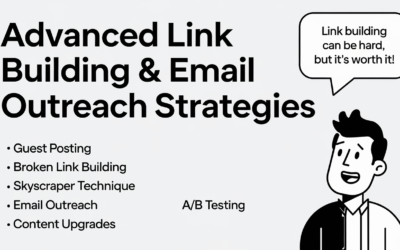How To Use Content Analytics To Grow Email And Social Media
Content analytics has become an invaluable set of skills in today’s digital landscape for the modern marketer to evolve and improve strategies with email and social media. Data-driven insights have optimized content, understood audience preferences, and eventually enabled growth across marketing channels. In this article, we will discuss how content analytics can help your emails and social media platforms get a boost, keeping you ahead in this constantly changing online landscape.
Understanding Content Analytics
Here, in the field of content analytics, one will gather and analyze data dealing with the performance of the content. This usually involves metrics such as rate of engagement, CTR, shares, and even conversions, and so on. In this way, you get an idea of whether or not your content is hitting the target and what else is required.
Why Content Analytics Matters for Email and Social Media
E-mail and social networks are pretty competitive spaces. Good content analytics would empower you in the following ways:
- Identification of Audience Preferences: The kinds, forms, and themes of content that resonate well with your audience.
- Optimize Content Strategy: All your future content decisions will be based on performance data.
- Increase Engagement Rates: Your content is better suited to drive more interactions and build more meaningful relationships with your audience.
- Drive Conversions: From those insights, your content not only will engage but also help you drive those conversions.
Step 1: Set Clear Goals
Before diving into content analytics, it is important to set defined goals for your email and social media campaigns. Common goals include:
- Open rate
- Grow followers
- Rise in engagement rate of posts
- Traffic to your website
- Creating leads or sales
Setting SMART goals will give you direction for the analytics efforts.
Step 2: Analytics Tools
To gather effective insights, analytics tools for email and social media are also used. Here is a sample of the most known analytics tools:
For Email Analytics
- Mailchimp: offers richer reporting features such as open rates, click-through rates, and audience insights.
- Campaign Monitor: offers in-depth reports of subscriber engagement and campaign performance.
- HubSpot: combines email analytics with customer relationship management (CRM) data for a holistic view of engagement.
For Social Media Analytics
- Hootsuite: tracking engagement metrics across all kinds of social platforms in one app- full analysis of performance
Sked Social: in-depth analytics for tracking performance, audience engagement, and competitor insights across multiple social platforms
- Sprout Social: any type of reporting on audience engagement, post-performance, and overall growth on social media
- Buffer: insights into the performance of posts, and optimal times to post.
Step 3: Analyze Engagement Metrics
So far, you have all set up your tools. Now it’s time to analyze the most important engagement metrics for how your content is performing. Analyze these:
Email Engagement Metrics
- Open Rates: This would give you an idea of the number of recipients who have opened your email. A bad rate might indicate that you need better subject lines or more targeted email lists.
- Click-through rates: the number of recipients who clicked on the hyperlinks to resources from your email. High click-through rates mean it’s successful so far by your call-to-action and rich content.
- Bounce Rates: percentage of emails that could not reach the inbox. Monitoring this can help keep a clean email list and enhance deliverability.
- Conversion rates: Number of recipients taking a specific action such as purchasing or signing up for a webinar. A high conversion rate shows that your email content converts to action through the recipient.
For Social Media Engagement Metrics
- Likes and Shares: This suggests the perceived value that people give to your message. Higher likes and shares mean that your content receives a higher organic reach.
- Comments: Comment engagement relates to audience interest and can lead to building communities and initiating dialogue conversations.
- Click-Through Rates: Similar to email, click-through rates on social media are a measure of how many users clicked on your links. That way, you understand the effectiveness of your content as well as CTAs.
- Follower growth: the growth in your follower count over time can be the best indicator of what works on social media and in your content.
Step 4: Audience Segmentation
By segmenting the audience, content can be delivered to targeted segments that can in turn increase engagement. Use content analytics to explore any existing segments with varying audience groups. These categories of audience segments differ in at least one of these three ways:
- Age, gender, locality
- Past purchase behaviour
- Past interaction behaviour with the contents.
Tailor your content to each segment of viewers, thereby increasing relevance and engagement. For example, if analytics show that a certain segment is engaging with educational content, you can fashion targeted newsletters or social media posts around that theme.
Step 5: Optimize Content Based on Insights
Optimizing Content Strategy After obtaining insights through gathering and analyzing, it is now the turn to optimize of content strategy. Some of them are listed below:
Email Optimization
- Personalize The Content: Utilize recipient names and adjust the content as per previous interactions with your brand. Personalized outreach is imperative for effective email communication.
- Test the Subject Lines: A/B testing of subject lines can be used to determine which one resonates the best with your audience for improved open rates.
- Optimize Send Times: Identify those times of day when your e-mails experience the most engagement and send your e-mail at those times.
- Refine CTAs: Ensure calls to action are clear, compelling, and in the right location in your e-mail to improve clicks.
Social media optimization
- Visual content: Identify using analytics what types of content are visual, such as images, video, infographics, etc., and introduce more of those in your overall strategy.
- Timing of engagement: Understand the time when your audience is most active on TikTok social media and ensure you post at those peak times.
- Content mix: Mix up the types of content that come in different ways, for example, polls, live videos, and user-generated content.
- Repurpose content into short videos: Reuse most-effective pieces of content and turn it into short-form videos. Instagram Reels from mid-sized accounts reach an average of 67,000 users, showcasing the platform’s ability to amplify short-video content.
- Respond to comments: Having a community of sorts can also spur more comments on your posts.
Step 6: Use A/B Testing
A/B testing is the best technique used to optimize the content across both email and social media. It compares a version against its counterpart for any given piece of content and determines which one performs better. Here’s how to apply A/B testing for maximum effect:
For Email
- Subject Lines: Compare different subject lines based on open rates.
- Content Layout: Use a different kind of format and, therefore, a different email structure by testing them to see which layout gives them higher engagement.
For Social Media
- Timing of post: Try to post throughout the day to see when your audience is most engaged.
- Type of post: Compare engagement with different types of content, such as video and image, to determine what best works.
Step 7: Monitoring and Iteration
Content analytics is not a one-time activity, but it’s an ongoing process. Monitor your metrics continuously, iterate your strategies, and keep informed of industry trends. Below are a few tips to help you remain agile:
- Stay Informed: Keep track of industry news and updates from your analytics tools for new features or metrics.
- Review Regularly: Schedule regular reviews of the analytics to identify trends, areas of improvement, and successful strategies.
- Be Adaptable: Be adaptive about changing your strategy based on data-driven insights. If something isn’t working, don’t be afraid to mix it up a bit.
Conclusion
With the integration of content analytics in email management and social media marketing, its outcome will surely improve. By setting precise goals, using appropriate tools, and continuous analysis and revision of content, your audience engagement grows as well as the performance. Digital landscapes are constantly changing, so to successfully use content analytics one needs to be adaptable and abreast of information. These, when put in action, will surely propel you to new heights in your engagements through emails and other social media uses, thereby getting higher and more convergent rates and loyalty.


